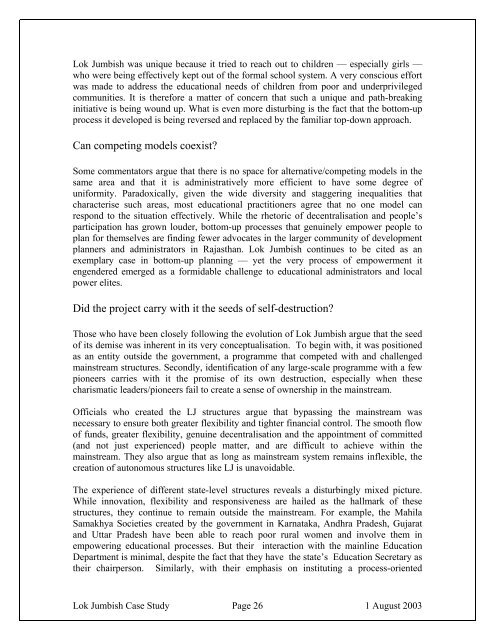Lok Jumbish was unique because it tried to reach out to children –– especially girls ––who were being effectively kept out of the formal school system. A very conscious effortwas made to address the educational needs of children from poor and underprivilegedcommunities. It is therefore a matter of concern that such a unique and path-breakinginitiative is being wound up. What is even more disturbing is the fact that the bottom-upprocess it developed is being reversed and replaced by the familiar top-down approach.Can competing models coexist?Some commentators argue that there is no space for alternative/competing models in thesame area and that it is administratively more efficient to have some degree ofuniformity. Paradoxically, given the wide diversity and staggering inequalities thatcharacterise such areas, most educational practitioners agree that no one model canrespond to the situation effectively. While the rhetoric of decentralisation and people’sparticipation has grown louder, bottom-up processes that genuinely empower people toplan for themselves are finding fewer advocates in the larger community of developmentplanners and administrators in Rajasthan. Lok Jumbish continues to be cited as anexemplary case in bottom-up planning –– yet the very process of empowerment itengendered emerged as a formidable challenge to educational administrators and localpower elites.Did the project carry with it the seeds of self-destruction?Those who have been closely following the evolution of Lok Jumbish argue that the seedof its demise was inherent in its very conceptualisation. To begin with, it was positionedas an entity outside the government, a programme that competed with and challengedmainstream structures. Secondly, identification of any large-scale programme with a fewpioneers carries with it the promise of its own destruction, especially when thesecharismatic leaders/pioneers fail to create a sense of ownership in the mainstream.Officials who created the LJ structures argue that bypassing the mainstream wasnecessary to ensure both greater flexibility and tighter financial control. The smooth flowof funds, greater flexibility, genuine decentralisation and the appointment of committed(and not just experienced) people matter, and are difficult to achieve within themainstream. They also argue that as long as mainstream system remains inflexible, thecreation of autonomous structures like LJ is unavoidable.The experience of different state-level structures reveals a disturbingly mixed picture.While innovation, flexibility and responsiveness are hailed as the hallmark of thesestructures, they continue to remain outside the mainstream. For example, the MahilaSamakhya Societies created by the government in Karnataka, Andhra Pradesh, Gujaratand Uttar Pradesh have been able to reach poor rural women and involve them inempowering educational processes. But their interaction with the mainline EducationDepartment is minimal, despite the fact that they have the state’s Education Secretary astheir chairperson. Similarly, with their emphasis on instituting a process-orientedLok Jumbish Case Study Page 26 1 August 2003
structure of functioning, the Lok Jumbish and Shiksha Karmi projects have managed towork with their target population –– the very poor, but are yet to be absorbed by themainstream system. 115ox 129 -re autonomous societies the answer to administrative bottlenecks_The appropriateness of autonomous institutions (called societies in India) to implement special programmesand projects is an issue that still vexes educational administration. While the idea of establishing statutoryinstitutions like University Grants Commission and Board of Secondary Education and Universities hasbeen accepted across the world, the creation of parallel structures to implement projects and programmeshas been contentious. In 1986–87, the Government of India and the Government of Rajasthan agreed to setup a society called the Shiksha Karmi Board to implement the Swedish-assisted innovative educationprogramme. Like other NGOs in India, this government-sponsored body was registered under the SocietiesRegistration Act, but with one significant difference: its formal leader was to be an ex-officio member ofthe government, i.e., the Education Secretary of the state. It was hoped that this would provide thestructure the flexibility and openness of an NGO, and at the same time give it the outreach, legitimacy andauthority of a government body. The combination of the two was viewed as a necessary mechanism formobilising girls and for reaching out to children in remote areas through paraprofessional teachers. It wasalso argued that relaxing rules for recruitment and organising intensive ongoing support and training wouldnot be possible within the rigid formal school system.The Shiksha Karmi Board thus set a new precedent. Subsequently, almost all special projects, includingdistrict-level implementation mechanisms under the Total Literacy Campaign and a range of EFA projects,adopted this structure. The government registered these societies under the formal leadership and control ofthe civil service (Lok Jumbish, which is chaired by a retired civil servant, is an exception). For all practicalpurposes, these societies are controlled by the formal administrative system, although the systems adoptedfor channelling funds and recruitment might differ from those followed by government bodies.How does a structure of this kind interact with the mainstream? Experience of 10 state-level structuresreveals a disturbing picture. While hailed for their innovation, flexibility and responsiveness, they are notintegrated into the mainstream. Flexible rules and the more liberal systems for dispensing travel and otherallowances create imbalances –– leading to petty jealousy among the government staff. There have beeninstances when mainline administrators have consciously created financial bottlenecks for these structures.The moot point is whether the valuable experience of these special projects administered by autonomoussocieties will be adapted by mainstream structures. Existing evidence is not very encouraging, especially inthe social sectors and those involving special focus groups. It is argued that the cumbersome, processorientedimplementation, monitoring and accountability systems that are essential for social mobilisation,cannot be replicated in mainstream structures. Others argue that the unit cost of special projects withspecial structures is not replicable.Notwithstanding above criticism, the smooth flow of funds, greater flexibility, genuine decentralisation andappointment of committed people make a difference. It is argued that as long as mainstream systemsremain rigid, the government, donor agencies and leaders with a vision cannot but create autonomousstructures. By:assing the main artery Hecomes a necessity Chen it is cloggedY atro:hied or -ossilised.Source9 Vimala Ramachandran 1998.Autonomous bodies have also been able to create a different work culture. Monitoringmechanisms are tight, and officials working in these projects admit that accountability to11 Vimala Ramachandran with Harsh Sethi 2001.Lok Jumbish Case Study Page 27 1 August 2003












